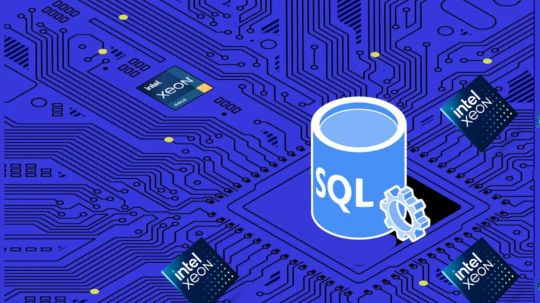#olap*
Explore tagged Tumblr posts
Text

How Power BI and OLAP Cubes Improve Your Business
Learn how Power BI and OLAP cubes enhance business intelligence by providing robust data analysis, interactive reporting, and improved decision-making for better business outcomes. This is where tools such as Power BI and OLAP cubes become handy, changing how organizations analyze data.
1 note
·
View note
Text
5th Gen Intel Xeon Scalable Processors Boost SQL Server 2022

5th Gen Intel Xeon Scalable Processors
While speed and scalability have always been essential to databases, contemporary databases also need to serve AI and ML applications at higher performance levels. Real-time decision-making, which is now far more widespread, should be made possible by databases together with increasingly faster searches. Databases and the infrastructure that powers them are usually the first business goals that need to be modernized in order to support analytics. The substantial speed benefits of utilizing 5th Gen Intel Xeon Scalable Processors to run SQL Server 2022 will be demonstrated in this post.
OLTP/OLAP Performance Improvements with 5th gen Intel Xeon Scalable processors
The HammerDB benchmark uses New Orders per minute (NOPM) throughput to quantify OLTP. Figure 1 illustrates performance gains of up to 48.1% NOPM Online Analytical Processing when comparing 5th Gen Intel Xeon processors to 4th Gen Intel Xeon processors, while displays up to 50.6% faster queries.
The enhanced CPU efficiency of the 5th gen Intel Xeon processors, demonstrated by its 83% OLTP and 75% OLAP utilization, is another advantage. When compared to the 5th generation of Intel Xeon processors, the prior generation requires 16% more CPU resources for the OLTP workload and 13% more for the OLAP workload.
The Value of Faster Backups
Faster backups improve uptime, simplify data administration, and enhance security, among other things. Up to 2.72x and 3.42 quicker backups for idle and peak loads, respectively, are possible when running SQL Server 2022 Enterprise Edition on an Intel Xeon Platinum processor when using Intel QAT.
The reason for the longest Intel QAT values for 5th Gen Intel Xeon Scalable Processors is because the Gold version includes less backup cores than the Platinum model, which provides some perspective for the comparisons.
With an emphasis on attaining near-real-time latencies, optimizing query speed, and delivering the full potential of scalable warehouse systems, SQL Server 2022 offers a number of new features. It’s even better when it runs on 5th gen Intel Xeon Processors.
Solution snapshot for SQL Server 2022 running on 4th generation Intel Xeon Scalable CPUs. performance, security, and current data platform that lead the industry.
SQL Server 2022
The performance and dependability of 5th Gen Intel Xeon Scalable Processors, which are well known, can greatly increase your SQL Server 2022 database.
The following tutorial will examine crucial elements and tactics to maximize your setup:
Hardware Points to Consider
Choose a processor: Choose Intel Xeon with many cores and fast clock speeds. Choose models with Intel Turbo Boost and Intel Hyper-Threading Technology for greater performance.
Memory: Have enough RAM for your database size and workload. Sufficient RAM enhances query performance and lowers disk I/O.
Storage: To reduce I/O bottlenecks, choose high-performance storage options like SSDs or fast HDDs with RAID setups.
Modification of Software
Database Design: Make sure your query execution plans, indexes, and database schema are optimized. To guarantee effective data access, evaluate and improve your design on a regular basis.
Configuration Settings: Match your workload and hardware capabilities with the SQL Server 2022 configuration options, such as maximum worker threads, maximum server RAM, and I/O priority.
Query tuning: To find performance bottlenecks and improve queries, use programs like Management Studio or SQL Server Profiler. Think about methods such as parameterization, indexing, and query hints.
Features Exclusive to Intel
Use Intel Turbo Boost Technology to dynamically raise clock speeds for high-demanding tasks.
With Intel Hyper-Threading Technology, you may run many threads on a single core, which improves performance.
Intel QuickAssist Technology (QAT): Enhance database performance by speeding up encryption and compression/decompression operations.
Optimization of Workload
Workload balancing: To prevent resource congestion, divide workloads among several instances or servers.
Partitioning: To improve efficiency and management, split up huge tables into smaller sections.
Indexing: To expedite the retrieval of data, create the proper indexes. Columnstore indexes are a good option for workloads involving analysis.
Observation and Adjustment
Performance monitoring: Track key performance indicators (KPIs) and pinpoint areas for improvement with tools like SQL Server Performance Monitor.
Frequent Tuning: Keep an eye on and adjust your database on a regular basis to accommodate shifting hardware requirements and workloads.
SQL Server 2022 Pricing
SQL Server 2022 cost depends on edition and licensing model. SQL Server 2022 has three main editions:
SQL Server 2022 Standard
Description: For small to medium organizations with minimal database functions for data and application management.
Licensing
Cost per core: ~$3,586.
Server + CAL (Client Access License): ~$931 per server, ~$209 per CAL.
Basic data management, analytics, reporting, integration, and little virtualization.
SQL Server 2022 Enterprise
Designed for large companies with significant workloads, extensive features, and scalability and performance needs.
Licensing
Cost per core: ~$13,748.
High-availability, in-memory performance, business intelligence, machine learning, and infinite virtualization.
SQL Server 2022 Express
Use: Free, lightweight edition for tiny applications, learning, and testing.
License: Free.
Features: Basic capability, 10 GB databases, restricted memory and CPU.
Models for licensing
Per Core: Recommended for big, high-demand situations with processor core-based licensing.
Server + CAL (Client Access License): For smaller environments, each server needs a license and each connecting user/device needs a CAL.
In brief
Faster databases can help firms meet their technical and business objectives because they are the main engines for analytics and transactions. Greater business continuity may result from those databases’ faster backups.
Read more on govindhtech.com
#5thGen#IntelXeonScalableProcessors#IntelXeon#BoostSQLServer2022#IntelXeonprocessors#intel#4thGenIntelXeonprocessors#SQLServer#Software#HardwarePoints#OLTP#OLAP#technology#technews#news#govindhtech
0 notes
Text
Announcing DuckDB 1.0.0 To install the new version, please visit the installation guide. For the release notes, see the release page.
— https://ift.tt/YCOVSum
0 notes
Text

Crystal Reports Migration to Jasper! OdiTek's Jaspersoft reporting, migrating, consulting services enables enterprise with data-driven decision making.
#crystal reports#jasper OLAP#SSIS Reporting tools#Jasper AD HOC Reports#Jasper views and domains#SSRS reporting tools
0 notes
Text
OLAP On AWS | Kyligence Cloud-Native Big Data Solution

Olap Aws users manage, analyze, and get the most from their cloud data assets with higher performance and lower cost.
0 notes
Text
14. Wie wird Amazon Redshift für Cloud Computing verwendet?: "MHM Digitale Lösungen UG: Wie Sie Amazon Redshift für Cloud Computing effizient nutzen können"
#CloudComputing #AmazonRedshift #Performance #Storage #Analytics #OLAP #Datenbanken #Datenmanagement #Skalierbarkeit #Sicherheit
Cloud Computing ist mittlerweile ein zentraler Bestandteil vieler Unternehmen. Mit Amazon Redshift können alle möglichen Cloud Computing Anwendungen durchgeführt werden. Amazon Redshift ist eine skalierbare Cloud-basierte Datenbank, die als Massenspeicher- und Analyseplattform für unternehmensinterne und externe Daten dienen kann. Es verfügt über eine Reihe hochentwickelter Funktionen, die es…
View On WordPress
#Amazon Redshift#Analytics#Cloud Computing#Datenbanken#Datenmanagement#OLAP#Performance#Sicherheit#Skalierbarkeit#Storage
0 notes
Video
youtube
Clickhouse : OLAP vs OLTP ???
0 notes
Text
Understanding OLAP: The Power of Online Analytical Processing
OLAP, or Online Analytical Processing, is a technology that allows users to analyze large, complex data sets in real time. It enables users to perform complex queries and data analysis on data sets from multiple sources quickly and easily. If you are wondering what is OLAP, OLAP systems are designed to help users make informed decisions by providing timely and accurate data that can be easily…

View On WordPress
0 notes
Text


[ 13th june, 2023 • 56/100 days of uni ]
my part of the BD project is done. it's finally done! it took so long, but it's done. i think i'll need to make some changes in the OLAP queries, but the SQL queries should be golden👌 aside from that, it wasn't a very productive day and i didn't sleep well, but hopefully i'll be tired enough to go to bed early tomorrow 🩷🩷
#stargazerbibi#study#studyblr#100 dop#100 days of productivity#student#studyspo#studyspiration#studystudystudy#aesthetic#productivity#studygram#studying#study hard#study blog#studysthetics#photography#photos#sunrise#moon#college#uni#university
128 notes
·
View notes
Text


OLAP/Reverse Palo Special
4 notes
·
View notes
Text
Olap, vengo con un dibujo en tradicional de Miku0, la vdd disfrute mucho pintando a acuarelas y... Y claro que no voy a hablar del dibujo, voy a hablar de mi vida, y de como lo que llevamos de año ha sido una kk en mi vida, lo único bueno fue Changbin y el canon de Teto enfin

#dibujo#vocaloid#vocaart#vocaloid fanart#fanart#fanloid#hastune miku#hatsune mikuo#dibujo tradicional#acuarela#vampire#blood
7 notes
·
View notes
Text
Fanatics 99.3
Gaz fights four aliens in the competition’s first battle.
For anyone who didn’t see my update post, I’ve decided to change my schedule. Instead of updating every other Saturday, Fanatics will now update every Saturday!
*Links to previous and next chapters in reblog*
--
Greatest in the Galaxy Part 3
“Hold him.”
Zim, Tak, and Pepito grab Dib, holding him still as Gaz leaves their sky box.
“You got this, Gaz,” Squee cheers from where he’s sitting at a table while Shmoopy looks over his legs.
“She can’t fight!” Dib exclaims, sick with worry.
“No, Dib, you’re mistaken,” Pepito argues, “Gaz fights all the time.”
“Y-yeah, but...but...”
“She has to fight, Dib,” Zim demands, “it’s for the competition.” “Yeah, so stop being such a baby!” Tak snaps.
Gaz ignores all of them as she heads down to the stadium grounds, her war hammer resting on her shoulder.
She emerges from the dimly lit corridors into the bright lights of the arena, surrounded by the cheering of the audience. She stares around, smiling with excitement.
“Look at her,” Kio says from their balcony, everyone else watching beside her. “She’s already loving this.” Dib grips the railing, whimpering uneasily.
Gaz and her four opponents- Tav of Irk, Olap of Swif’el, Wirez of Techon-3, and Peccs of Mus’ular- approach the middle of the ring and stand in a circle, glaring at each other.
“This is an all-out, anything-goes, free-for-all! Players are encouraged to not completely annihilate their opponents- this is a friendly competition after all- but don’t expect anyone to jump in if things start getting out of hand.” “Do people often get killed in these battles?” Squee asks as he limps over.
“Not often,” Zim replies, “but it’s not uncommon.” “How are your legs?” Pepito asks.
“I’ll be alright,” Squee smiles.
“Begin!”
Gaz flinches as everyone looks at her. Peccs swings his large fists; spider legs extend from Tav’s PAK and begin firing lasers; Olap rushes for her, claws unsheathing from his top paws; Wirez grabs a laser gun from his belt and fires.
Gaz jumps backwards, narrowly dodging all of the attacks.
“Oh! Just like last round, the returning players are ganging up on the newbie! How long will Gaz be able to hold out?”
Gaz races around the arena, dodging laser fire from Tav and Wirez and keeping out of range of Peccs and Olap. The onslaught is barely giving her time to think let alone retaliate.
“This isn’t fair!” Dib exclaims, “they can’t gang up on her! She’s just a sweet, little girl!”
“She’s neither of those things,” Squee argues.
“Knock it off with the older brother complex, Dib,” Pepito groans, “this is Gaz we’re talking about. If there’s one thing she can do, it’s fight dirty.”
Gaz takes a sudden left and Peccs skids to a stop. But as he starts to turn after her, lasers hits his back.
“Whoops,” Wirez grunts, lowering his gun.
“Watch it, Techon,” Peccs snarls, “or I’ll crush you.”
“You stay out of my way, Mus’ules!” Wirez snaps backs.
“What’d you say to me, vermin,” the giant growls and stomps up to the smaller alien. Wirez starts firing at him, but Peccs walks into the lasers like they’re just rain. Wirez presses a button on his belt, activating a jetpack that carries him out of the range of Peccs long arms.
With those two occupied, Gaz just has to worry about Tav and Olap. The two stay focused on her. Olap’s speed and agility is tough to keep up with as he matches all of Gaz’s movements.
He crouches on all six limbs and lunges for her like a missile. Gaz barely has time to bring up her war hammer to block, and he tackles her to the ground.
“Gaz!” Dib cries.
Olap lies on top of her, pinning her to the ground with his bottom four arms while his top two are held back by her hammer’s handle. Olap snarls at her, his face only inches from her. Then suddenly, she opens her mouth and bites his nose.
“Oh!” her friends exclaim.
Olap cries out in pain as her teeth digs in his flesh and tries to scurry back. Gaz lets him go, spits out yellow blood, and swings her hammer. She smashes him square in the chest and sends him tumbling across the arena.
Wiping her mouth, Gaz stands up and glares at Tav. He glares back and starts firing his lasers again. She runs for him, sidestepping each laser, and throws her hammer. It spins through the air right for him. He stops firing so he can use his spider legs to block the heavy weapon. As it falls, he sees Gaz right in front of him, fist raised.
She swings at him. With not enough time to block, Tav falls to his knees to dodge and her arm flies over his head.
His spider legs lunge at her. Gaz quickly kicks up her hammer and uses it to block and knocks the appendages off course, but they still slice the sides of her arms. She winces but doesn’t back off.
She swings her leg, kicking Tav in the chest and sending him flying back. His spider legs quickly catch him, digging into the ground, and throw him back. Gaz lifts her hammer, ready to swing, as Tav’s spider legs lunge at her.
The appendages slice across her chest as her hammer smashes into him and sends him crashing into the wall.
Gaz pants, leaning against her hammer as blood drips from her fresh wounds. She doesn’t have long to relax, however, as a large shadow looms over her. She looks back as Peccs swings down at her. She narrowly dodges by leaping out of the way.
“Nice job taking down that Irken,” he says, “and the Swif too. Now it’s just you and me.”
Gaz looks over to where Wirez is lying unconscious on the ground. At some point, Peccs managed to jump up to him flying in the sky and send him crashing back down.
She snarls and swings her hammer into Peccs’ chest. It’s a dead-hit, but he doesn’t even flinch.
“Heh, nice try,” he chuckles, “but we Mus’ules are practically indestructible.”
“Huh,” Gaz grunts, slowly backing away.
“Don’t worry, I won’t break you,” he says, “well, maybe just a little.”
“You talk too much,” Gaz groans.
He swings at her and she skips backwards to dodge. She’s a lot slower and clumsier than before, his large fists almost grazing her. She keeps moving until she backs into the wall.
“End of the line, little one!” Peccs exclaims and swings at her. Gaz leaps to the right to dodge and he smashes the wall.
Before he has a chance to move, Gaz skids around to his back and jabs the end of her hammer’s handle into the back of his knees, causing him to lose his balance and fall against the hall. Then she scrambles onto his back and pulls back her hammer.
“Don’t worry, I won’t break you,” she says.
She smashes her hammer into the back of Peccs’ head, slamming his face into the wall. He twitches before going limp.
Gaz slips off Peccs’ back and takes a look around the arena. Tav, Olap, and Wirez are also lying around, unconscious.
“We have a winner! The last one standing is Gaz of Earth!”
“Yeah!” her team cheers on their balcony, waving and jumping up and down. Soon, the rest of the audience joins in.
“That’s the second win in a row for Earth, putting them officially in first place with ten points!”
Gaz grins and victoriously holds her hammer high.
#invader zim#invader zim fanfiction#johnny the homicidal maniac#johnny the homicidal maniac fanfiction#iz jthm crossover#myocs#myart
6 notes
·
View notes
Text
ClickHouse or StarRocks? Here is a Detailed Comparison While StarRocks and ClickHouse have a lot in common, there are also differences in functions, performance, and application scenarios. Check out this breakdown of both! A New Choice of Column DBMS Hadoop was developed 13 years ago.
— https://ift.tt/OuPeUFB
0 notes
Text
CS 442/561 Programming Assignment 1
Objectives In this assignment, you will express “complex” OLAP queries in SQL. The key point of the exercise is to observe the complexity of expressing the type of such queries despite the relatively simple ideas of the queries themselves. Your mission (in addition to writing the SQL queries) is to consider the reasons for the complexity of the expression of these queries. Report…
0 notes